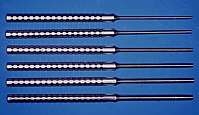Osteotome
An osteotome is an instrument used for cutting or preparing bone.[1] Osteotomes are similar to a chisel but bevelled on both sides.[2] They are used today in plastic surgery, orthopedic surgery and dental implantation.[3]

Osteotomes used in dental implantation

Bernhard Heine's osteotome

Component parts of the osteotome, and the instrument in use
The chain osteotome, originally referred to simply as the osteotome, was invented by the German physician Bernhard Heine in 1830.[4][5] This device is essentially a small chainsaw.[6][7]
See also
References
- Gould, George Milbry; Scott, Richard John Ernst (1919). The Practitioner's Medical Dictionary: Containing All the Words and Phrases Generally Used in Medicine and the Allied Sciences, with Their Proper Pronunciation, Derivation, and Definition. P. Blakiston's. pp. 639–. Retrieved 2 December 2012.
- Swiontkowski, Marc F. (2012-09-10). Manual of Orthopaedics. Lippincott Williams & Wilkins. pp. 209–. ISBN 9781451115925. Retrieved 2 December 2012.
- Summers, Robert B. (1994). "A new concept in maxillary implant surgery: the osteotome technique" (PDF). Compendium. Newtown, Pa. 15 (2): 152–154.
- The Lancet London: A Journal of British and Foreign Medicine, Surgery, Obstetrics, Physiology, Chemistry, Pharmacology, Public Health and News. Elsevier. 1835. pp. 127–.
- Seufert, Wolf D. (1980). "The Chain Osteotome by Heine". Journal of the History of Medicine and Allied Sciences. XXXV (4): 454–459. doi:10.1093/jhmas/XXXV.4.454. ISSN 0022-5045.
- Peltier, Leonard F. (1993). Orthopedics: History and Iconography. Norman Publishing. pp. 37–. ISBN 9780930405472. Retrieved 2 December 2012.
- Tillmanns, Hermann (1895). The principles of surgery and surgical pathology: general rules governing operations and the application of dressings. D. Appleton and company. pp. 84–. Retrieved 2 December 2012.
| Look up osteotome in Wiktionary, the free dictionary. |
This article is issued from
Wikipedia.
The text is licensed under Creative
Commons - Attribution - Sharealike.
Additional terms may apply for the media files.